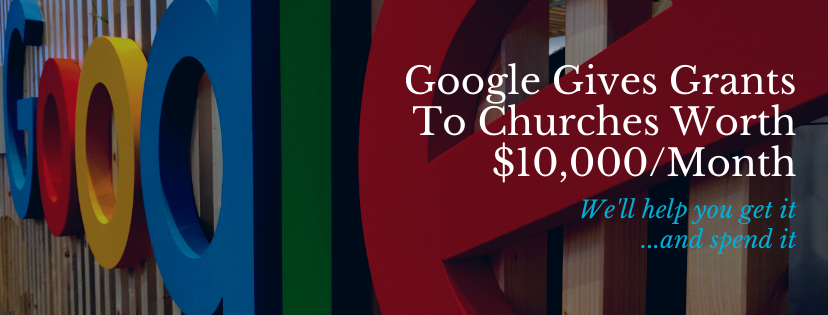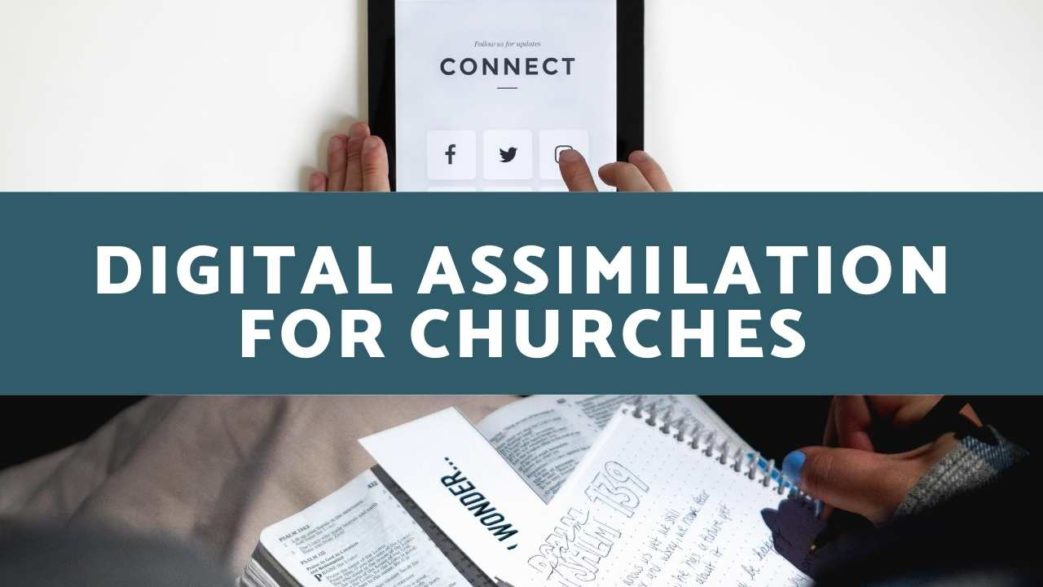Digital assimilation is the process of welcoming new people to your church. This includes everything from the first time they interact with your church online until they feel like part of your church family.
Having a great assimilation process can make the difference between people staying or leaving. Whether people are joining you in person or online, they still want to feel welcome.
Before anyone else joins your church family, sit down with your team to create a welcoming assimilation process that keeps new people engaged and excited.

Include A Welcome Section On Your Website
Your church website is one of your best digital assimilation tools. The first step is to create a dedicated welcome section. It’s a great way to help welcome new visitors. This includes people who are finding your church via your website for the first time or those visiting your church in person for the first time.
Start by providing details about your church. Consider adding a short welcome video that briefly introduces your church, main staff and ministry programs.
Give them insight into all the ways they can get involved in the church. You can always link to various pages on your website for more in-depth information, such as your Ministries page.
The idea is to make this area of your website a one-stop-shop for everything new visitors and members would need to know. This makes it easier to assimilate new people into your church family because they feel more comfortable and welcome immediately.
Pin A Welcome Message To Social Media
Many people find or at least check out your church on social media after attending or when looking for a new church. Use your church’s social media page to welcome them and give them some necessary information.
Obviously, you don’t want your message getting lost as you post new content. So, pin it to the top of your page. For instance, on Facebook, it only takes a few steps to pin any post so it’s always visible at the top of your page.
You can link back to your church’s website to offer even more details. However, this ensures you have a digital welcome, along with details and resources, on social media too.
Make sure you add details about your church’s social media page and any groups on your website’s welcome page. If they found your church’s site first, this makes it easy for them to quickly jump to social media to start interacting. This also helps them meet some of your current members and online followers to feel more like part of the family faster.
Plus, if they have questions, many people would rather send a quick message on social media or post a question in the comments. So, make sure someone’s monitoring your social accounts to answer questions.
Make Contact Details Easy To Find
This might seem simple, but you’d be surprised at how many churches don’t make their contact details easy to find. While having a contact form is great, sometimes people want to know who they’re contacting.
In addition to a contact form, add contact details to your church website’s footer and a contact page. Your details should include a phone number, email address, address and social media channels. On your Contact page, add information about how soon to expect a response based upon the contact method. This ensures people don’t feel ignored when contacting you.
You can also create a directory for digital assimilation. People can easily contact the person they need versus a general number or email address. Plus, this takes some of the burden off of whoever has to manage church messages.

Gather Contact Details
It’s important to be able to reach out to new visitors. After all, staying in contact shows visitors that you really care about them. Plus, it gives you a chance to provide more details and them to ask questions.
Encourage everyone, both online and off, to provide contact details. Ask them to list their preferred contact method(s), such as call, text or email. Personalizing how you contact people makes them happier and more likely to provide their details.
One other thing to do is explain why you want the contact details. Let people know that you simply want to be able to follow-up and welcome all new visitors. Ensure them that there’s no pressure to join, donate or volunteer. In fact, for in-person visitors, you can even say it’s okay for them to attend online if they prefer. The less pressure, the more welcome people feel.
Staying in contact is also a way to keep people engaged. After all, which church would you rather interact with? A church that says “hi” when you first attend and that’s all or a church that follows up to see how you are and if you have any questions. Most would say the latter.
Answer The Most Common Questions
When you’ve been part of the church for so long, you might forget what it’s like for new visitors. You might not realize how many questions they might have. In most cases, you probably see the most important questions as things like “what are the service times” and “what denomination is the church.”
However, you’d be surprised at just how many questions your new visitors have. A great digital assimilation strategy anticipates common questions and provides answers on the church website. It’s a good idea to link to new visitor FAQs on your social media accounts too.
Some questions you’ll definitely want to answer include:
- What’s your church really like? (go beyond your denomination and mission statement)
- What should I expect when I arrive? (where to park, where to enter, where to sit)
- What is the pastor’s personality like?
- What are sermons like and how long are they?
- What programs are in place for children? (ministries, services, groups, etc.)
- What kind of music do you play?
- What age groups attend your church regularly?
- Is there anyone to direct new people?
- Are your members welcoming to new visitors?
- How should I dress?
- What options are available for attending online?
- Who can I ask questions in person? (add pictures)
- What’s the overall culture? (lively, solemn, etc.)
- What if I’ve never attended church before or it’s been a while?
Children’s Ministry offers a good example of why it’s important to make this information readily available. Their site also shows why it’s key to make a good first impression.
Digital assimilation resources on your website makes this process much easier. You should also have a welcome desk at your church’s front doors for those who attend in person for the first time without checking out your site first.
Provide Livestream Sessions
Sometimes, new visitors may feel a little intimidated attending the first time. Help assimilate them before they attend in person by offering livestreaming sessions.
The most obvious type is your weekly sermons. They can attend a service online to get a feel for your church in the comfort of their own home. For online-only visitors, they get to be a part of a live service versus just watching a recorded video. This makes them feel much more like part of the church family. Just make sure to address them in someway so they know they’re truly a part of things.
However, this isn’t the only livestreaming option you have. You can also have special sessions just for new visitors, both online and in-person, to attend. Set times where you’ll livestream on Facebook to chat with people to answer questions.
You can also let your members get involved. Let them hold Q&A sessions as well so new visitors hear about your church from actual members versus church staff.

Create A Downloadable Handbook
While not crucial, a downloadable handbook is a great digital assimilation tool. Put everything new visitors need to know in a quick reference guide. This should be a simple PDF with cheat sheets that people can access offline.
For example, you might have a page with a local map showing the easiest routes to your church. Since mobile data signals still aren’t the best, especially in rural areas, this offers an alternative to GPS and your church website if they lose Internet access.
Some other things to include are:
- Service times
- Names of social media accounts
- Contact details
- Where to enter
- Where the information desk is
- Your church’s mission statement
- Ministry programs (add contact details if possible)
- Children’s programs
- Overview of church demographics
- What to expect your first time
- Where new visitors should go online (use full URLs instead of saying “our church website”)
- How tithing works, especially if you offer online tithing
Each of these items can be a separate page with bullet points for quick reference.
Schedule Meet & Greet Times
One thing that’s often skipped with digital assimilation programs is meeting others. New visitors want to feel like part of the church family, but sometimes that’s easier said than done. It’s not that your members aren’t welcoming, but they might get caught up talking to each other and miss out on saying hi to new people.
Ensure you have several volunteers to welcome any new visitors in person. Then, provide a welcome packet or a card with your church’s website. You can even add a QR code that takes them directly to your church’s welcome page.
Schedule meet and greet times and list them on your welcome page. Visitors, both in person and online-only, can attend. During these sessions, people can video or voice chat. Ask several members to host each session. Different members can do different sessions.
This allows everyone to spend more time meeting each other. Even your online-only church followers are able to assimilate into your church by getting to meet each other and your in-person members.
You can even continue hosting meet and greet sessions for everyone to stay in contact with each other.
Plan Office Hours Just For New People
New visitors are never sure when the right time to contact you is. This might prevent them from asking questions and even from coming back.
So, prevent this. Have office hours specifically for new people. This can be an hour each day where you only answer emails from new visitors. Add an option in your contact form for new visitor questions.
People can also call you, schedule a video chat or even come by in person. List these hours on the welcome page of your church website.
Also, make sure your members know about these special office hours so they don’t interrupt unless it’s an emergency.

Create A Member’s Only Section Of Your Website
If possible, consider setting up a member’s only section of your website. While the name might be deceiving, it’s not just for members. This is just a special section of your site where users log in.
This section should include a forum for people to talk with each other. People who don’t really like social media may prefer this option. It also offers a place for online-only followers to participate as well.
You can also include special resources to aid in the digital assimilation process. For instance, you might have an area just for new visitors and members. Not only can they interact with each other, but you can provide special resources on how to get more involved, what to do if your children don’t want to attend and how to feel more like a long-time member than brand new.
Create A Facebook Group To Interact
If you don’t want to create a member’s only section, create a Facebook group to interact. This can be a closed or private group to keep things safer. Provide details on how to join the group on your church’s website. For instance, for a private group, list who to contact in order to receive an invitation.
Give this information to new visitors in-person as well. Encourage your members to participate as much as possible to welcome new people and make them feel like they’ve finally found their church home.
Continue To Reach Out
Even after people have successfully assimilated, continue to reach out. Post questions on social media to see if people have any complaints or suggestions. Have online office hours for everyone to contact you. Maintain an active social media community or even a community on your church website.
Every successful digital assimilation strategy needs a great church website to power it. Contact us today to get started.





Comments 3
This was helpful. Thank you.
Author
So glad it helped!